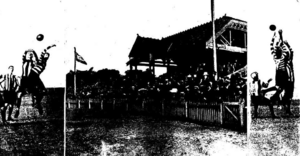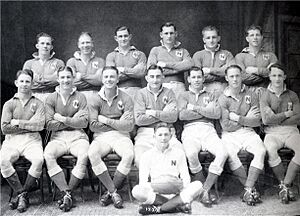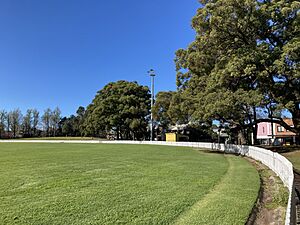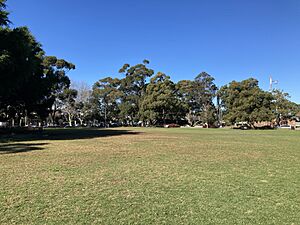Erskineville Oval facts for kids
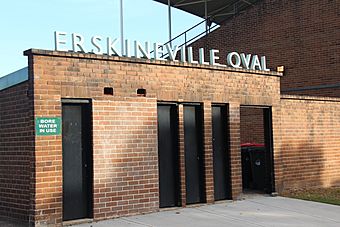 |
|
| Location | 149 Mitchell Road, Erskineville |
|---|---|
| Owner | City of Sydney |
| Operator | City of Sydney |
| Capacity | 5000 |
| Surface | Grass |
| Construction | |
| Broke ground | 1885 |
| Opened | 1885 |
| Renovated | 1937, 2006 |
| Tenants | |
| Newtown (NSWRL) (1913–1954) Alexandria Rovers |
|
Erskineville Oval is a historic sports ground in Erskineville, Sydney, Australia. It first opened in 1885 as Macdonaldtown Park. Later, in 1892, it was renamed Erskineville Oval. This happened when the local area changed its name to Erskineville.
The oval can hold about 5,000 people. It has been a home for many different sports teams over the years. These include Australian Rules Football (AFL) and Rugby League teams. Famous teams like the Newtown Jets and the South Sydney Rabbitohs have played or trained here.
Contents
Erskineville Oval's Story: A Look Back
The land where Erskineville Oval sits has a long history. It was first granted to people like Nicholas Divine in the late 1700s. For many years, the land was not developed due to legal issues. Finally, on July 28, 1885, 22 acres were officially named Macdonaldtown Park.
In 1892, the park's name changed to Erskineville Oval. This change matched the new name of the local government area. The oval has been updated twice, in 1937 and again in 2006. These changes helped shape the oval into what it is today. It has hosted many sports, including AFL, rugby league, and cricket. Today, it is home to the Erskineville Gazelles, a semi-professional rugby league team.
Sports Played at Erskineville Oval
Since it opened in 1885, Erskineville Oval has been a busy sports hub. It became a key ground for the NSW Australian Football League in 1903. Later, it also hosted rugby league, baseball, and even boxing training.
Australian Rules Football History
Erskineville Oval was an important ground for the New South Wales Football League from 1903. The Newtown team played many of their home games here. One of the first matches was between East Sydney and Alexandria Football Clubs.
In 1909, a big game between Geelong Football Club and Collingwood Football Club from the Victorian Football League was played here. Many fans came to watch. The oval continued to host important AFL games in the 1910s and 1920s. This included premiership final games in 1910, 1914, and 1919.
The original Newtown Football Club stopped playing in 1987. A new junior club started in 1999. They now play at Alan Davidson Oval in Sydney Park. AFL umpires also used Erskineville Oval for their training.
Rugby League's Time at the Oval
Rugby league games started at Erskineville Oval in 1906. The Newtown club, formed in 1908, made it their home ground from 1913 to 1954. During this time, the Newtown club won two premierships in the NSW Rugby Football League. These wins were in 1933 and 1943.
Newtown later moved to Henson Park in 1954. This was because Erskineville Oval could no longer handle the large crowds. The last top-grade rugby league match at the oval was on March 26, 1954. Newtown won that game against Canterbury-Bankstown 16–13.
Today, the oval is a home ground for Souths Juniors. It also hosts The Alexandria Rovers and the Erskineville Gazelles. The South Sydney Rabbitohs also used it as a temporary training ground from 2006 to 2008. This helped fund improvements to the oval.
Baseball and Boxing Training
From 1932, Erskineville Oval became a main ground for baseball games in Sydney during the summer.
The oval is also a regular training spot for many boxing athletes. Famous trainer Johnny Lewis has coached boxers here since the 1960s. World champions like Jeff Fenech, Jeff Harding, and Kostya Tszyu trained on the grandstand steps. They would often start their training as early as 6 AM.
Oval Upgrades and Changes
Erskineville Oval has had two major renovations. The first was in 1937 as part of a government housing plan. The second was in 2006, before the South Sydney Rabbitohs used it for training.
1937 Housing Scheme Changes
In 1937, the oval was part of the NSW Government's Erskineville Rehousing Scheme. This project built new homes and a child care center called Lady Gowrie. These buildings were put on and around the oval. This housing scheme was special because it was one of the few built during that time.
After the project finished in 1940, the oval was rebuilt. A new street, Fox Avenue, was added. This street split the original oval land into two parts. The new section, next to Fox Avenue, was later named Harry Nobel Reserve in 1960.
2006 Modern Upgrades
In 2006, Erskineville Oval received many upgrades. These were done to prepare for the South Sydney Rabbitohs to use it for training. The City of Sydney Council and the rugby club worked together on these changes. The council provided $300,000 for the project.
The upgrades included improving the playing surface and adding a fence around the oval. Seating was increased and made better. New paths for people to enter from Ashmore Street were added. Training lights and public toilets were also improved for players and fans.
Protecting Erskineville Oval's Heritage
The area around Erskineville Oval is a special heritage conservation area. This includes the oval, Harry Nobel Reserve, and the Erskineville Housing Scheme. The buildings from the 1937 housing scheme are considered historic. They show how architects thought about design and social issues back then.
The Lady Gowrie child care facility, built in 1940, is also part of this heritage area. It was designed by important architects. This facility is one of several built across Australia in the 1930s. It is protected for its historical importance and what it shows about child care in that era.
Harry Nobel Reserve: A Neighboring Park
Harry Nobel Reserve was once part of Erskineville Oval. After the 1937 housing project, the land was divided by Fox Avenue. The main part remained Erskineville Oval. The other section was officially named Harry Nobel Reserve in 1960. This was to honor Harry Nobel, a local politician who passed away in 1949.
Fun and Unusual Events at the Oval
Erskineville Oval has seen some interesting events over the years!
The Macdonaldtown Park 50 Yard Race
In January 1902, a funny local running race happened at Macdonaldtown Park. It was a 50-yard race for men who weighed over 17 stone (about 106 kg). Five competitors took part. The winner received a medal and a ham, while others got smaller prizes.
A Cricket Game Stopped by a Cow
In 1905, a cricket match was interrupted in a very unusual way. A stray cow wandered onto the field and sadly died right on the wicket! The game had to be stopped. At that time, it was common for local farmers to have many cows in the area.
The Case of the Stolen Ground
Before the Newtown Jets moved in 1954, Erskineville Oval was their home. In 1950, parts of the oval's grass mysteriously disappeared. It turned out a schoolboy named Warren Allen was taking squares of turf every day. He replanted them in his backyard to make his own football field!


